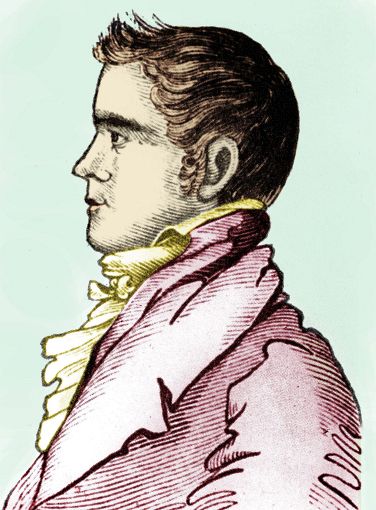|
"He was not the type of person a traveler would want to meet in a lonely spot," wrote one early-day crime historian of Samuel Green, who became the terror of New England and one of America's first arch criminals. Heavyset and muscular, Green stood five-foot-eight-inches. He showed the world a savage-looking face and burning dark eyes. The strange fires raging inside of him were more fierce and threatening than his physical appearance. He was a product of the whip, a cherished item of discipline in early 19th Century America. To say that this inhuman burglar and killer was created by the stern-minded adults who ruled his childhood is an understatement in the annals of crime.
Born in Meredith, New Hampshire, Green was routinely thrashed by his parents, who employed switches to beat him into obedience, particularly when he was truant from school. He was apprenticed to a blacksmith at an early age and, when caught stealing, was horsewhipped. He was sent home, where he was again severely whipped. He retaliated by throwing the family dog down a well, its dead body turning the water bad and causing the family considerable expense in digging a new well. Again, Green was whipped.
Green then stabbed farm animals and destroyed more property, his frustrated parents finally sending him to live with a stern family friend, Albert Dunne. His conduct did not improve. He killed Dunne's farm animals and destroyed his property, for which he was routinely whipped. On one occasion, Dunne whipped the boy so severely that a layer of flesh on his back was peeled back.
At one point, Green tried to kill Dunne, arranging a large ax to fall upon his guardian, but it missed its mark. For his clumsy attempt to kill his guardian, Green was tied to a barn door and whipped until his back was a welted, bloody mass of flesh. Green finally gave up his plans to murder Dunne and departed, roaming the small New Hampshire towns where he met another embittered and battered youth, William Ash.
Both traveled together to Newhampton, where they encountered a traveling salesman named Franklin Loomis, who sold household goods, but whose real livelihood came from illegal activities. Loomis took Green and Ash under his wing, becoming their criminal mentor, teaching them the techniques of forging false bank notes and, especially, how to burglarize the homes of the rich, as well as business and banking institutions.
Branching out, Green began his criminal career as a lone burglar. He was not concerned if the occupants were present or not when he broke into homes. Any person unlucky enough to awake while he was at work was quickly clubbed senseless (many were murdered) by the invader. Green looted vast amounts of silverware, jewels, cash and other valuable items, selling his stolen goods to fences his mentor had provided. He burglarized business offices in Guilford, New Hampshire and then rode to Burlington, Vermont, where he continued his burglaries, amassing a small fortune.
Green then met up once more with Loomis, who spent weeks showing him how to pick locks and duplicate keys to enhance his methods of burglary. He teamed up again with Ash and both men went on a burglarizing spree, entering and looting hundreds of homes and offices. While traveling to Bath, New Hampshire, both young men encountered a jewelry salesman, who imprudently showed them some of his gems. Green clubbed him to death and both made off with the jewels.
Green sold off the jewels and pocketed thousands of dollars. He left Ash and went off on his own. He was arrested and jailed several times on suspicion, but evidence was lacking to indict him and he was routinely released. After looting a jewelry store in Montreal, Canada, Green was pursued by a posse. He fought his way out of a trap, shooting and killing several men, but he was later apprehended and jailed. He was tried, convicted and sentenced to death, but his friend Ash helped him to escape.
|
 |
 |
 |
| Samuel Green, arch burglar, thief and murderer, who went to the hangman in 1822. |
Returning to the remote mountains of New Hampshire, Green hid for some months. He then went on another crime spree, burglarizing stores and homes in Albany, New York and New York City. Although he was chiefly a burglar, Green did not hesitate to commit armed robbery. In Middlebury, Vermont, he robbed and shot to death a wealthy French traveler.
By this time, nothing was beyond the ambitions of Samuel Green. He left a trail of burglary, rape, horse-stealing, counterfeiting and murder from Montpelier, Vermont, to Schenectady, New York; from Saco, Maine, to Barre, Vermont. He became America's first Public Enemy Number One. Half the country was looking for him and the bounties offered for his capture were large.
The great fugitive's end began when he was arrested and convicted of burglary in Danvers, Massachusetts. Green was sent to prison in Boston to serve a four-year term. He made many attempted to escape. One of Green's escape attempts had been thwarted by another inmate, a black prisoner named Billy Williams, who had informed prison officials of Green's plans. Green cornered Williams alone in a prison shop on the morning of November 8, 1821, where he beat him to death with an iron bar.
Convicted of murdering Williams, Green was sentenced to death, mounting the gallows on April 24, 1822. Before Green dropped through the trapdoor, he told a priest, who was praying at his side, that he had no words for the hundreds of spectators gathered about the gallows to witness his execution. "They shall not know my fate," he said cryptically. "I have written out my confession in full."
"Are you penitent, my son?" asked the priest.
Samuel Green, with the rope around his neck, gave the priest a long stare and then a thin smile curled upward as he replied: "If you wish it."
|